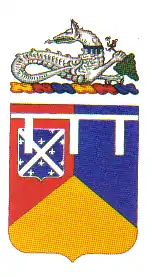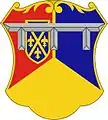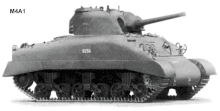66th Armor Regiment
The 66th Armor Regiment is the oldest armored unit in the United States Army, tracing its lineage to the 301st Tank Battalion which served with distinction soon after it was formed in the First World War; the 301st trained at Camp Meade, Maryland, where then Cpt. Dwight D. Eisenhower was an instructor. It has often been rumored that the 301st, the parent unit of the 66th, was first commanded by Col. George S. Patton, but this appears not to have been the case; while Patton was the first officer assigned to the Tank Corps, and while the 301st Tank Battalion was the first unit formed, Patton went nearly immediately to France to train Americans attached to Allied commands.[1] The 301st was the only American heavy tank battalion to have seen action in the war. After the war, the 301st transitioned in the Regular Army to become the 66th Infantry Regiment (Light Tanks) by way of the 16th Tank Battalion.[2]
| 66th Armor Regiment | |
|---|---|
 66th Armor Regiment coat of arms | |
| Active | 1918–present |
| Country | |
| Branch | |
| Type | Armor |
| Role | Armored warfare |
| Size | Two battalions |
| Garrison/HQ | Fort Carson, CO (1st Battalion); Fort Riley, KS (3rd Battalion) |
| Nickname(s) | "Burt's Knights" |
| Motto(s) | Semper in Hostes |
| Engagements | World War I World War II Korean War Operation Desert Storm Iraq War |
| Commanders | |
| Notable commanders | George S. Patton (304th Tank Brigade) |
| Insignia | |
| Distinctive unit insignia |  |
Current disposition
Two battalions of the regiment are still in service in the Regular Army.
- 1–66 AR is assigned to the 3rd Brigade Combat Team of the 4th Infantry Division at Ft. Carson. The First Battalion has participated in combat operations in Operation Iraqi Freedom and in Operation Enduring Freedom.
- 3–66 AR is assigned to the 1st Armored Brigade Combat Team, 1st Infantry Division garrisoned at Ft Riley, Kansas. The Third Battalion has participated in combat operations in Operation Iraqi Freedom and in Operation Enduring Freedom.
History
World War I
The 1st and 2nd Provisional Brigades of the United States Tank Corps would eventually go on to provide the original cadre for what would become the 66th Armored Regiment in World War II. In September 1918 both brigades - which were attached to the 1st Infantry Division in France - participated in the battle of St. Mihiel and the Meuse-Argonne Offensive, operating French-built Renault FT tanks. Five days before the Armistice with Germany, the brigades were renamed respectively the 304th and 305th Brigades, Tank Corps on 6 November 1918.
The casualties in the unit led General John J. Pershing to say: "The percentage of casualties among the officers and men tells the tale of splendid morale and gallantry in action and their unselfish devotion to duty". The regiment's Organization Day was chosen as 12 September to commemorate its baptism of fire at St. Mihiel.
The Headquarters and Headquarters Companies (HHC) of the 304th and 305th Tank Brigades transferred in 1919 to Camp Meade, Maryland and consolidated on 22 June 1921, reorganized and redesignated as HHC, 1st Tank Group. This organization reorganized and was redesignated HHC, 1st Tank Regiment on 1 September 1929, as the 66th Infantry Regiment (Light Tanks) on 25 October 1932. In 1936 and 1937, Bruce Magruder commanded the 66th Infantry Regiment at Camp Meade, Maryland.[3] When the regiment received its first two light tanks, unit members decided to name one for Magruder, and his wife took part in the christening ceremony.[3] As the 66th Armored Regiment, on 15 July 1940, the organization become part of the newly formed 2nd Armored Division, stationed at Fort Benning, Georgia.
World War II
In December 1942 the regiment was part of the amphibious invasion of Morocco in North Africa and led the division's entry into Casablanca. The regiment next participated in the invasion of Sicily.

On 10 June 1944 (D+4), the three battalions of the regiment landed on Gold Beach in Normandy. Four days later the regiment (as part of Combat Command A of the 2nd Armored Division) fought through elements of the German 6th Fallschirmjäger Regiment of the 2nd Fallschirmjäger Division and elements of the 17th SS Panzergrenadier Division southwest of Carentan, France at the Battle of Bloody Gulch. Later progress was also initially difficult in combat against elements of the newly arrived 116th Panzer Division and surviving elements of the Panzer Lehr Division. In a difficult battle in the streets of the village of Percy and on surrounding high ground on 30 July, against some of the eight Panthers Generalleutnant Fritz Bayerlein had found and rallied from workshops at neighboring Villebaudon on 28 July, the 3/66th was to lose 13 tanks and was forced to pull out of the city losing another five tanks outside Centry to heavy Nebelwerfer and other mortar fire. On 31 July 3/66th was down to only 24 operational tanks. The regiment fought across France to the German border with the rest of the division and the U.S. Third Army, but was diverted north to counter the German advance during the Battle of the Bulge, assisting in the destruction of the 2nd Panzer Division and capturing Houffalize, Belgium.
The regiment was twice cited in the Order of the Day of the Belgian Army. Captain James M. Burt, the commander of B Company, 66th Armored Regiment, was awarded the Medal of Honor for his heroism during the Battle of Aachen in October 1944. Captain Burt later served as Honorary Colonel of the Regiment.
Cold War
Following the war, elements of the 66th and other units of the 2nd Armored Division were selected to occupy the American sector of Berlin and serve as the first American troops to enter the fallen German capital.
During the Korean War, an offspring of the 66th fought under the designation "6th Tank Battalion". During the war, the sixth won seven battle streamers and the Korean Presidential Unit Citation. These honors were awarded to the 66th Armored Regiment when the 6th Tank Battalion was inactivated after the conflict.
Throughout the Cold War, the four battalions of the regiment served in the 2nd Armored Division at Ft. Hood, Texas, and as part of the 2nd Armored Division (Forward) in the Federal Republic of Germany.
Desert Storm
In 1991, during Operation Desert Storm, the regiment assisted in the liberation of Kuwait and the defeat of the Iraqi army. The 2nd and 3rd battalions of the regiment, stationed in Germany as part of the 2nd Armored Division (Forward), deployed and fought under the operational control of the 1st Infantry Division as part of Task Force 1-41 Infantry. The 4th Battalion, along with the 3d (Phantom) Brigade of the 3rd Infantry Division, was attached to the 1st Armored Division. The 2nd and 3rd battalions served in the Battle of 73 Easting and the Battle of Norfolk. The Phantom Brigade became the 1st Armor's lead brigade for VII Corps' "left hook" to smash the Iraqi Republican Guard divisions. It served in the largest tank battle in American history at the Battle of Medina Ridge.

In the spring of 1995, the 1st Battalion of the 66th was assigned to assist over 5,000 Cuban and Haitian refugees interned at Guantanamo Bay, Cuba.
Global War on Terror
The 1st and 3rd Battalions deployed to Iraq in support of Operation Iraqi Freedom and Afghanistan in support of Operation Enduring Freedom. 3–66 Armor was deployed to Operation Iraqi Freedom for 2003–2004 and 1-66 Armor deployed shortly after 3-66 Armor to Operation Iraqi Freedom from 2003-2004 as well. 1-66 Armored Regiment also deployed to Operation Iraqi Freedom from 2008–2009. This was the last tour of duty for 1-66 Armor BN while stationed at Fort Hood, TX before relocating to Fort Carson, CO. 1-66 Armor BN was then deployed to Operation Enduring Freedom from 2010–2011, as part of the surge in the volatile Arghandab River Valley west of Kandahar City in RC-South. 3-66 Armor BN was recently deployed to Operation Enduring Freedom from 2011-2012 to Paktika Province in RC-East.
Coat of arms
- Shield: Tierced in pairle reversed gules, azure, and or, in dexter chief an escutcheon azure semé-de-lys or charged with saltire of the last; overall, a label of three points argent
- Crest: On a wreath of the three colors a wyvern couchant reguardant to sinister argent, grasping in its dexter claw a pine tree inverted and eradicated proper, and charged on its neck with a label of three points azure
- Motto: "Semper in Hostes" (Always into the enemy).
- Symbolism: The coat of arms was originally approved for the 15th Tank Battalion, part of which was in the old 304th Tank Brigade. Therefore, the shield and crest of the 304th Tank Brigade are used with the label added for difference. The shield is of the colors of the Tank Corps shoulder sleeve insignia. The Brigade was organized at Langres, France, in 1918, and the arms of Langres are shown on an escutcheon with the saltire changed from red to gold for difference. The wyvern is from the original insignia of the French Tank Corps. The uprooted pine tree commemorates the activities of the brigade in the Argonne Forest during the Meuse-Argonne operations.
Lineage
World War I
- Organized in August 1918 in the American Expeditionary Forces in France as Headquarters and Headquarters Companies, 1st and 2d Provisional Brigades, Tank Corps.
- Redesignated 6 November 1918 as Headquarters and Headquarters Companies, 304th and 305th Brigades, Tank Corps, respectively
- Consolidated and redesignated 22 June 1921 as Headquarters and Headquarters Company, 1st Tank Group
- Reorganized and redesignated 1 September 1929 as Headquarters and Headquarters Company, 1st Tank Regiment; remainder of the 1st Tank Regiment organized from existing units as follows:
- 16th Tank Battalion reorganized and redesignated as the 1st Battalion, 1st Tank Regiment (16th Tank Battalion organized in 1918 as Headquarters and Headquarters Company, 327th Battalion, Tank Corps, and Company C, 1st Separate Battalion, Heavy Tank Service, 65th Engineers)
- 15th Tank Battalion reorganized and redesignated as the 2d Battalion, 1st Tank Regiment (15th Tank Battalion organized in 1918 as Headquarters and Headquarters Company, and Companies A and C, 1st Battalion, 1st Tank Center, and Company A, 1st Separate Battalion, Heavy Tank Service, 65th Engineers)
- 18th Tank Battalion redesignated as the 3d Battalion, 1st Tank Regiment (18th Tank Battalion organized in 1918 as the 329th Battalion, Tank Corps, and Headquarters and Headquarters Company, 328th Battalion, Tank Corps; inactivated 29 July 1922)
- 21st Tank Maintenance Company redesignated as the Service Company (21st Tank Maintenance Company organized in 1918 as the 316th Repair and Salvage Company, Tank Corps)
- (3d Battalion activated 16 September 1931 at Camp Devens, Massachusetts)
- 1st Tank Regiment converted and redesignated 25 October 1932 as the 66th Infantry (Light Tanks)
- (Headquarters and Headquarters Company, 66th Infantry [Light Tanks] inactivated 1 September 1938 at Fort George G. Meade, Maryland; Headquarters Company activated 16 October 1939 at Fort George G. Meade, Maryland; Headquarters activated 10 January 1940)
World War II
- Converted and redesignated 15 July 1940 as the 66th Armored Regiment and assigned to the 2d Armored Division
- Regiment broken up 25 March 1946 and its elements reorganized and redesignated as elements of the 2d Armored Division as follows:
- Regimental Headquarters and Headquarters Company, 1st Battalion, and Company D as the 66th Tank Battalion
- 2nd Battalion (less Company D) and Headquarters Company, 3d Battalion, as Headquarters and Headquarters Company, Companies A and B, and Service Company, 6th Tank Battalion (remainder of 6th Tank Battalion organized from elements of the 67th Armored Regiment)
- Reconnaissance Company as Troop D, 82d Cavalry Reconnaissance Squadron, Mechanized
- Service Company as the Service Company, 12th Armored Infantry Battalion
- (Band as the 2d Armored Division Band hereafter – separate lineage)
- 3d Battalion (less Headquarters Company) and Maintenance Company disbanded
- After 25 March 1946 the above units underwent changes as follows:
- 66th Tank Battalion redesignated 5 January 1949 as the 66th Medium Tank Battalion Redesignated 1 April 1953 as the 66th Tank Battalion Inactivated (less Company A) 1 July 1957 in Germany and relieved from assignment to the 2d Armored Division
- 6th Tank Battalion redesignated 31 January 1949 as the 6th Medium Tank Battalion Relieved 14 July 1950 from assignment to the 2d Armored Division Assigned 29 October 1950 to the 24th Infantry Division Redesignated 10 November 1951 as the 6th Tank Battalion Inactivated 5 June 1958 in Korea and relieved from assignment to the 24th Infantry Division
- Troop D, 82d Mechanized Cavalry Reconnaissance Squadron, redesignated 17 January 1948 as Company D, 82d Reconnaissance Battalion Inactivated 1 July 1957 in Germany and relieved from assignment to the 2d Armored Division
- Service Company, 12th Armored Infantry Battalion, redesignated 11 October 1948 as Company D, 12th Armored Infantry Battalion Inactivated 1 July 1957 in Germany and relieved from assignment to the 2d Armored Division
- Maintenance Company and Companies G, H, and I, 66th Armored Regiment, reconstituted 1 July 1957 in the Regular Army
- 6th Tank Battalion (less Companies C and D); 66th Tank Battalion; Company D, 82d Reconnaissance Battalion; Company D, 12th Armored Infantry Battalion; and the Maintenance Company and Companies G, H, I, 66th Armored Regiment, consolidated, reorganized and redesignated 1 July 1957 as the 66th Armor, a parent regiment under the Combat Arms Regimental System (Companies C and D, 6th Tank Battalion reorganized and redesignated as elements of the 67th Armor—hereafter separate lineages)
- Withdrawn 1 October 1983 from the Combat Arms Regimental System and reorganized under the United States Army Regimental System
Honors
Campaign participation credit
- World War I:
- St. Mihiel;
- Meuse-Argonne
- World War II:
- Algeria-French Morocco (with arrowhead);
- Sicily (with arrowhead);
- Normandy;
- Northern France;
- Rhineland;
- Ardennes-Alsace;
- Central Europe
- Korean War:
- UN Defensive;
- UN Offensive;
- CCF Intervention;
- First UN Counteroffensive;
- CCF Spring Offensive;
- UN Summer-Fall Offensive;
- Second Korean Winter;
- Korea, Summer 1953
- Southwest Asia:
- Defense of Saudi Arabia;
- Liberation and Defense of Kuwait;
- Cease-Fire
- Afghanistan Campaign
- Iraqi Campaign
Decorations
- Presidential Unit Citation (Army) for NORMANDY
- Presidential Unit Citation (Army) for VIRE RIVER
- Presidential Unit Citation (Army) for ROER RIVER
- Valorous Unit Award for IRAQ-KUWAIT
- Valorous Unit Award for IRAQ OIF 07-09 New Baghdad
- Belgian Fourragere 1940
- Cited in the Order of the Day of the Belgian Army for action in BELGIUM 1944
- Cited in the Order of the Day of the Belgian Army for action in the ARDENNES
- Meritorious Unit Citation (3RD BN) awarded 10 March 2010 for Operation Iraqi Freedom 08-10
- Army Superior Unit Citation, Task Force XXI Advanced Warfighting Experiment.
Bibliography
- American Forces in Action Series; Historical Division; United States Army Center of Military History
- Omaha Beachhead (6–13 June 1944); CMH Pub 100-11.
- Utah Beach to Cherbourg (6–27 June 1944); CMH Pub 100-12
- ST-LO (7–19 July 1944); CMH Pub 100-13
- Other United States Army Center of Military History Publications
- United States Army in the Korean War; Policy and Direction: The First Year; CMH Pub 20-1-1
- South to the Naktong, North to the Yalu (June–November 1950) CMH Pub 20-2-1
- Truce Tent and Fighting Front; CMH Pub 20-3-1
- Ebb and Flow November 1950-July 1951; CMH pub
- Other Publications
- Barth, George B. Tropic Lightning and Taro leaf in Korea. N.p.: 1953.
- Blumenson, Martin. Breakout and Pursuit. 1961
- Cole, Hugh M. The Ardennes: Battle of the Bulge. 1965
- Harrison, Gordon A. Cross-Channel Attack. 1951
- Garland, Albert N., and Howard McGaw Smith. Sicily and the Surrender of Italy. 1965
- Howe, George F. Northwest Africa: Seizing the initiative in the West. 1957
- MacDonald, Charles B. The Siegfried Line Campaign. 1963
- Stadtmauer, Saul A.., editor. A Pictorial History of the Victory Division in Korea. Tokyo, Japan: 1953
- Guderian, Major Heinz Gunther.., From Normandy to the Ruhr: With the 116th Panzer Division.
- Bayerlein, Generalleutnant Fritz.., After Action Reports of the Panzer Lehr Division Commander: From D-Day To the Ruhr.
References
- Blaker, Gordon A. (1999). Iron Knights: the United States 66th Armored Regiment. Shippensburg, PA: Burd Street Press. pp. 1–2.
- Blaker, Gordon A. (1999). Iron Knights: The United States 66th Armored Regiment. Shippensburg, PA: Burd Street Publisher. pp. 23–24.
- "A Brand New Service Tradition". National Defense. 17. Arlington, VA: American Defense Preparedness Association. 1936. p. 370 – via Google Books.
![]() This article incorporates public domain material from the United States Army Center of Military History document: "Lineage and Honors 66th Armor (Iron Knights)".
This article incorporates public domain material from the United States Army Center of Military History document: "Lineage and Honors 66th Armor (Iron Knights)".
External links
| Wikimedia Commons has media related to 66th Armor Regiment. |